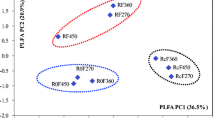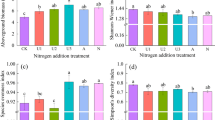Abstract
Changes in grazing regime and climatic conditions (such as precipitation) may affect soil N2O emissions; however, such effects have been inconsistent in grasslands. This study investigated the impact of simulated grazing, increased precipitation and N addition on soil N2O emissions, as well as soil dissolved organic carbon (DOC) concentrations, from a mixed grassland site in southern Alberta, Canada. A batch incubation study was conducted on soils (0–10 cm) collected from long-term field plots exposed to defoliation at either high intensity at low frequency (HILF) or high intensity at high frequency (HIHF) or low intensity at high frequency (LIHF) throughout the growing season (May–August). A deferred control (DC) treatment was also included where defoliation only occurred once at year end. All defoliation treatments formed a full factorial experiment with the watering treatment (ambient moisture (AM) or watering (W)) in the field. Soil N2O production was also quantified under an N addition treatment (no N and addition of 20 mg N kg−1 (NH4)2SO4) in the laboratory incubation experiment. Defoliation had no influence (p > 0.05) on soil DOC concentrations and cumulative N2O emissions. Watering increased DOC concentrations by 72–234 % but decreased N2O emissions by 33–60 %. Increments in N2O emissions after N addition were greater in the W (111–163 %) than the AM (64–67 %) treatment. Our results suggest that while defoliation regimes did not affect soil N2O emissions, watering may induce greater N2O loss in the more arid soil and N addition may further increase N2O loss under high precipitation within soils of the dry mixed grassland ecosystem.


Similar content being viewed by others
References
Adams BW, Poulin-Klein L, Moisey D, Mcneil RL (2005) Rangeland plant communities and range health assessment guidelines for the dry mixedgrass natural subregion of Alberta. Rangeland Management Branch, Public Lands Division, Alberta Sustainable Resource Development, Lethbridge
Ambus P, Robertson GP (2006) The effect of increased N deposition on nitrous oxide, methane and carbon dioxide fluxes from unmanaged forest and grassland communities in Michigan. Biogeochemistry 79:315–337
Basto S, Thompson K, Phoenix G, Sloan V, Leake J, Rees M (2015) Long-term nitrogen deposition depletes grassland seed banks. Nat Commun 6:6185
Bazot S, Mikola J, Nguyen C, Robin C (2005) Defoliation-induced changes in carbon allocation and root soluble carbon concentration in field-grown Lolium perenne plants: do they affect carbon availability, microbes and animal trophic groups in soil? Funct Ecol 19:886–896
Bell CW, Tissue DT, Loik ME, Wallenstein MD, Acosta Martinez V, Erickson RA, Zak JC (2014) Soil microbial and nutrient responses to 7 years of seasonally altered precipitation in a Chihuahuan Desert grassland. Global Change Bio 20:1657–1673
Braun M, Bai YG, Mcconkey B, Farrell R, Romo JT, Pennock D (2013) Greenhouse gas flux in a temperate grassland as affected by landform and disturbance. Landscape Ecol 28:709–723
Chen WW, Zheng XH, Chen Q, Wolf B, Butterbach-Bahl K, Bruggemann N, Lin S (2013) Effects of increasing precipitation and nitrogen deposition on CH4 and N2O fluxes and ecosystem respiration in a degraded steppe in Inner Mongolia, China. Geoderma 192:335–340
Crawford MC, Grace PR, Oades JM (2000) Allocation of carbon to shoots, roots, soil and rhizosphere respiration by barrel medic (Medicago truncatula) before and after defoliation. Plant Soil 227:67–75
Cuhel J, Simek M, Laughlin RJ, Bru D, Cheneby D, Watson CJ, Philippot L (2010) Insights into the effect of soil pH on N2O and N2 emissions and denitrifier community size and activity. Appl Environ Microbiol 76:1870–1878
Du R, Lu D, Wang G (2006) Diurnal, seasonal, and inter-annual variations of N2O fluxes from native semi-arid grassland soils of inner Mongolia. Soil Biol Biochem 38:3474–3482
Fay PA, Carlisle JD, Knapp AK, Blair JM, Collins SL (2003) Productivity responses to altered rainfall patterns in a C4-dominated grassland. Oecologia 137:245–251
Fierer N, Jackson RB (2006) The diversity and biogeography of soil bacterial communities. Proc Natl Acad Sci U S A 103:626–631
Fu MH, Xu XC, Tabatabai MA (1987) Effect of pH on nitrogen mineralization in crop-residue-treated soils. Biol Fert Soils 5:115–119
Galloway JN, Dentener FJ, Capone DG, Boyer EW, Howarth RW, Seitzinger SP, Asner GP, Cleveland CC, Green PA, Holland EA, Karl DM, Michaels AF, Porter JH, Townsend AR, Vörösmarty CJ (2004) Nitrogen Cycles: Past, Present, and Future. Biogeochemistry 70:153–226
Gu CH, Riley WJ (2010) Combined effects of short term rainfall patterns and soil texture on soil nitrogen cycling—a modeling analysis. J Contam Hydrol 112:141–154
Guitian R, Bardgett RD (2000) Plant and soil microbial responses to defoliation in temperate semi-natural grassland. Plant Soil 220:271–277
Hamilton EW, III, Frank DA, Hinchey PM, Murray TR (2008) Defoliation induces root exudation and triggers positive rhizospheric feedbacks in a temperate grassland. Soil Biol Biochem 40:2865–2873
Harrison-Kirk T, Beare MH, Meenken ED, Condron LM (2013) Soil organic matter and texture affect responses to dry/wet cycles: Effects on carbon dioxide and nitrous oxide emissions. Soil Biol Biochem 57:43–55
Holland EA, Detling JK (1990) Plant response to herbivory and belowground nitrogen cycling. Ecology 71:1040–1049
Hutchinson GL, Brams EA (1992) NO versus N2O emissions from an NH4 +-amended Bermuda grass pasture. J Geophys Res Atmos 97:9889–9896
IPCC (2007) Climate change 2007: the physical science basis. Contribution of working group I to the fourth assessment report of the intergovernmental panel on climate change. Cambridge University Press, Cambridge
IPCC (2013) Climate Change 2013. The physical science basis. Working group I contribution to the fifth assessment report of the intergovernmental panel on climate change. Cambridge University Press
Jackson RD, Oates LG, Schacht WH, Klopfenstein TJ, Undersander DJ, Greenquist MA, Bell MM, Gratton C (2015) Nitrous oxide emissions from cool-season pastures under managed grazing. Nutr Cycl Agroecosyst 101:365–376
Kammann C, Grunhage L, Muller C, Jacobi S, Jager HJ (1998) Seasonal variability and mitigation options for N2O emissions from differently managed grasslands. Environ Pollut 102:179–186
Kwak JH, Chang SX, Naeth MA, Schaaf W (2016) Coarse woody debris effects on greenhouse gas emission rates depend on cover soil type in oil sands reclamation. Appl Soil Ecol 100:124–134
Li P, Lang M (2014) Gross nitrogen transformations and related N2O emissions in uncultivated and cultivated black soil. Biol Fert Soils 50:197–206
Liu XC, Dong YS, Qi YC, Peng Q, He YT, Sun LJ, Jia JQ, Guo SF, Cao CC, Yan ZQ, Liu XH (2015) Response of N2O emission to water and nitrogen addition in temperate typical steppe soil in Inner Mongolia, China. Soil Tillage Res 151:9–17
Luo GJ, Kiese R, Wolf B, Butterbach-Bahl K (2013) Effects of soil temperature and moisture on methane uptake and nitrous oxide emissions across three different ecosystem types. Biogeosciences 10:3205–3219
Ma L, Shan J, Yan XY (2015) Nitrite behavior accounts for the nitrous oxide peaks following fertilization in a fluvo-aquic soil. Biol Fert Soils 51:563–572
Mo J, Zhang W, Zhu W, Gundersen P, Fang Y, Li D, Wang H (2008) Nitrogen addition reduces soil respiration in a mature tropical forest in southern China. Global Change Biol 14:403–412
Mosier AR, Pendall E, Morgan JA (2003) Effect of water addition and nitrogen fertilization on the fluxes of CH4, CO2, NOx, and N2O following five years of elevated CO2 in the Colorado Shortgrass Steppe. Atmos Chem Phys 3:1703–1708
Murray P, Ostle N, Kenny C, Grant H (2004) Effect of defoliation on patterns of carbon exudation from Agrostis capillaris. J Plant Nutr Soil Sci 167:487–493
Neftel A, Blatter A, Schmid M, Lehmann B, Tarakanov SV (2000) An experimental determination of the scale length of N2O in the soil of a grassland. J Geophys Res Atmos 105:12095–12103
Orchard VA, Cook FJ (1983) Relationship between soil respiration and soil moisture. Soil Biol Biochem 15:447–453
Paterson E, Thornton B, Midwood AJ, Sim A (2005) Defoliation alters the relative contributions of recent and non-recent assimilate to root exudation from Festuca rubra. Plant Cell Environ 28:1525–1533
Pearson J, Stewart GR (1993) The deposition of atmospheric ammonia and its effects on plants. New Phytol 125:283–305
Rafique R, Anex R, Hennessy D, Kiely G (2012) What are the impacts of grazing and cutting events on the N2O dynamics in humid temperate grassland? Geoderma 181:36–44
Ravishankara AR, Daniel JS, Portmann RW (2009) Nitrous oxide (N2O): the dominant ozone-depleting substance emitted in the 21st century. Science 326:123–125
Sainju UM, Stevens WB, Caesar-Tonthat T, Liebig MA (2012) Soil greenhouse gas emissions affected by irrigation, tillage, crop rotation, and nitrogen fertilization. J Environ Qual 41:1774–1786
Shen SSP, Yin H, Cannon K, Howard A, Chetner S, Karl TR (2005) Temporal and spatial changes of the agroclimate in Alberta, Canada, from 1901 to 2002. J Appl Meteorol 44:1090–1105
Simek M, Cooper JE (2002) The influence of soil pH on denitrification: progress towards the understanding of this interaction over the last 50 years. Eur J Soil Sci 53:345–354
Soussana JF, Lemaire G (2014) Coupling carbon and nitrogen cycles for environmentally sustainable intensification of grasslands and crop-livestock systems. Agric Ecos Environ 190:9–17
Stevens CJ, Dupre C, Dorland E, Gaudnik C, Gowing DJG, Bleeker A, Diekmann M, Alard D, Bobbink R, Fowler D, Corcket E, Mountford JO, Vandvik V, Aarrestad PA, Muller S, Dise NB (2010) Nitrogen deposition threatens species richness of grasslands across Europe. Environ Pollut 158:2940–2945
Suttie JM, Reynolds SG, Batello C (2005) Grasslands of the world. Food and Agricultural Organization of the United Nations, Rome
SCWG (Soil Classification Working Group) 1998. The Canadian system of soil classification. Agriculture and Agri-Food Canada Publication 1646 (Revised), Ottawa, ON, Canada. pp.187
Templer PH, Pinder RW, Goodale CL (2012) Effects of nitrogen deposition on greenhouse-gas fluxes for forests and grasslands of North America. Front Ecol Environ 10:547–553
Tian XF, Hu HW, Ding Q, Song MH, Xu XL, Zheng Y, Guo LD (2014) Influence of nitrogen fertilization on soil ammonia oxidizer and denitrifier abundance, microbial biomass, and enzyme activities in an alpine meadow. Biol Fert Soils 50:703–713
Zhang XM, Wei HW, Chen QS, Han XG (2014) The counteractive effects of nitrogen addition and watering on soil bacterial communities in a steppe ecosystem. Soil Biol Biochem 72:26–34
Acknowledgments
The authors would like to thank Sixi Zhu, Kangyi Lou, Yike Shen, Erica Schell, and Caroline Martin for their assistance in the field and laboratory. We also thank Editor-in-Chief and two anonymous reviewers for their valuable suggestions that improved an earlier version of the manuscript. Funding for this research was provided by the Rangeland Research Institute and the Mattheis Research Ranch, University of Alberta; the National Natural Science Foundation of China (41573070); and the Open Fund of the State Key Laboratory of Soil and Sustainable Agriculture, Institute of Soil Science, Chinese Academy of Sciences (Y412201403).
Author information
Authors and Affiliations
Corresponding author
Rights and permissions
About this article
Cite this article
Cai, Y., Chang, S.X., Ma, B. et al. Watering increased DOC concentration but decreased N2O emission from a mixed grassland soil under different defoliation regimes. Biol Fertil Soils 52, 987–996 (2016). https://doi.org/10.1007/s00374-016-1135-3
Received:
Revised:
Accepted:
Published:
Issue Date:
DOI: https://doi.org/10.1007/s00374-016-1135-3




